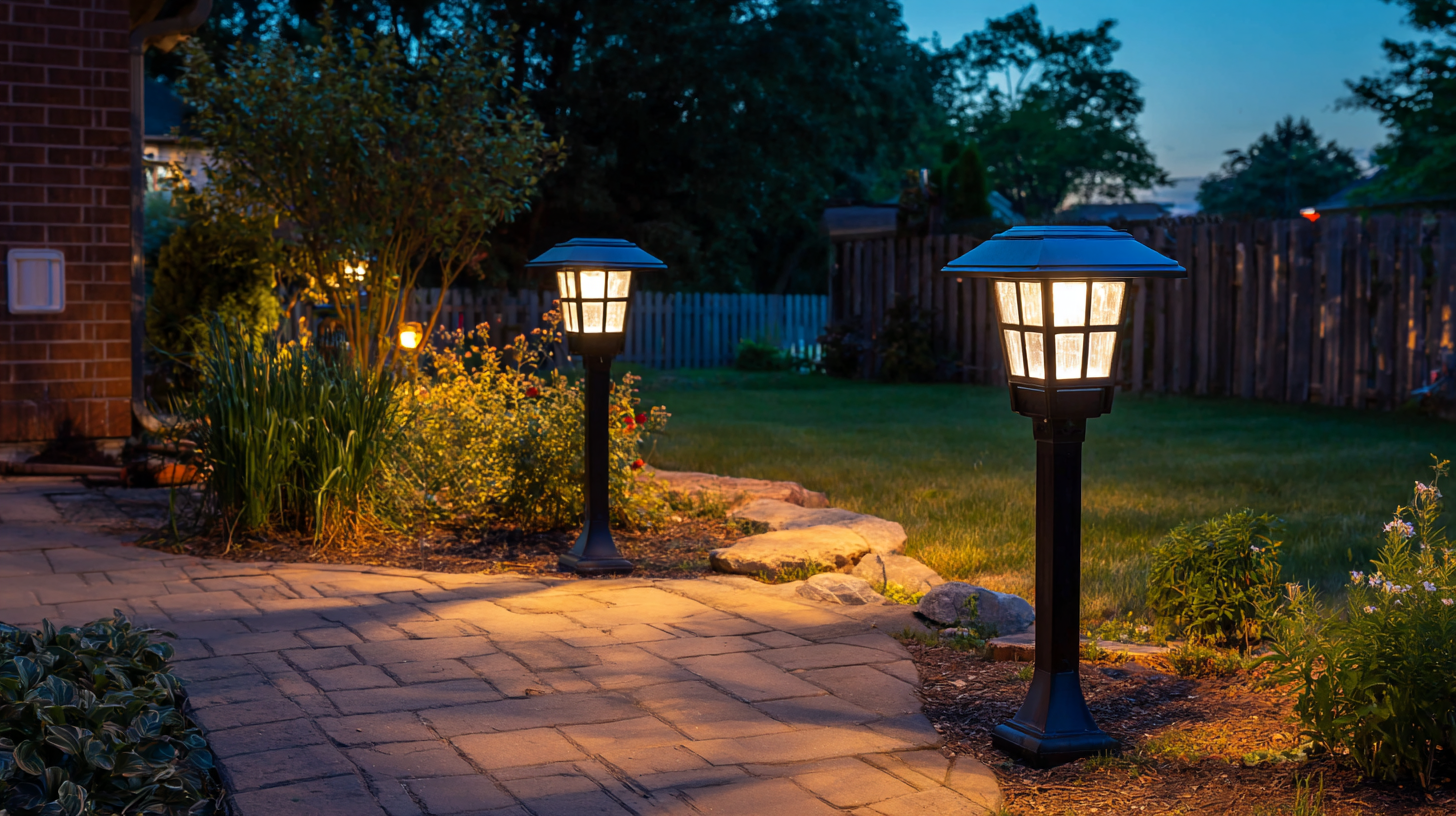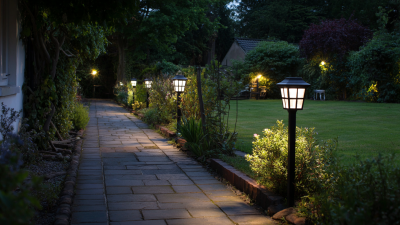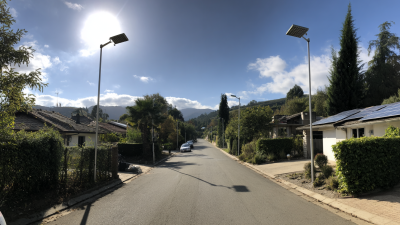Top 10 Solar Post Lights to Illuminate Your Outdoor Spaces in 2023
As the demand for sustainable energy solutions grows, solar post lights have emerged as a favorite among homeowners looking to enhance their outdoor spaces while minimizing their carbon footprint. According to a recent report by the Solar Energy Industries Association, the solar lighting market is expected to grow by over 20% annually, driven by advancements in technology and increasing awareness of environmental issues. "Solar post lights not only provide illumination but also symbolize the shift towards eco-friendly living," says Dr. Emily Carter, a leading expert in renewable energy solutions. This technology harnesses solar power to provide efficient, alternative lighting solutions that are both cost-effective and aesthetically pleasing.

In 2023, the landscape of solar post lights has evolved with various innovative designs and features aimed at meeting diverse consumer needs. From motion sensor capabilities to versatile styles, these lights serve practical purposes while enhancing the beauty of outdoor spaces. With the right selection, homeowners can illuminate driveways, gardens, and patios, all while enjoying significant savings on energy costs. As sustainability continues to take center stage, the rise of solar post lights represents not just a trend, but a fundamental shift in how we conceive outdoor lighting.
Why Solar Post Lights are Essential for Outdoor Spaces in 2025
As we look towards 2025, the significance of solar post lights in outdoor spaces becomes increasingly apparent. These lights not only provide essential illumination after dusk but also enhance the aesthetic appeal of gardens, patios, and walkways. With growing concerns about energy consumption and sustainability, solar post lights offer a practical solution that combines elegance with eco-friendliness. They harness solar energy during the day to automatically illuminate outdoor areas at night, reducing reliance on traditional power sources and lowering energy costs.
Moreover, the advancements in solar technology are making these lights more efficient and reliable than ever. With improved battery capacity and lighting fixtures, modern solar post lights now offer brighter and longer-lasting illumination, making them suitable for a variety of outdoor settings. Additionally, their easy installation and low maintenance requirements make them an attractive option for homeowners looking to enhance their outdoor environments. As we continue to prioritize sustainable living, solar post lights will undoubtedly become an essential element in creating beautiful and functional outdoor spaces.
Top 10 Solar Post Lights to Illuminate Your Outdoor Spaces in 2023
| Model | Brightness (Lumens) | Battery Life (Hours) | Material | Water Resistance Rating | Price ($) |
|---|---|---|---|---|---|
| Model A | 150 | 12 | Aluminum | IP65 | 49.99 |
| Model B | 100 | 10 | Plastic | IP44 | 39.99 |
| Model C | 200 | 14 | Steel | IP67 | 59.99 |
| Model D | 80 | 8 | Glass | IP54 | 35.99 |
| Model E | 120 | 11 | Aluminum | IP55 | 44.99 |
| Model F | 90 | 9 | Plastic | IP67 | 29.99 |
| Model G | 110 | 13 | Steel | IP68 | 54.99 |
| Model H | 170 | 15 | Aluminum | IP65 | 59.99 |
| Model I | 130 | 12 | Plastic | IP55 | 49.99 |
| Model J | 140 | 15 | Glass | IP68 | 69.99 |
Features to Look for in the Best Solar Post Lights
When selecting the best solar post lights for your outdoor spaces, several key features should be prioritized to ensure optimal performance and longevity. A recent report by Allied Market Research indicates that the solar lighting market is expected to reach $20.5 billion by 2027, highlighting the increasing demand for energy-efficient outdoor lighting solutions. Look for solar post lights with high-quality solar panels that can efficiently convert sunlight into energy, ensuring they stay illuminated throughout the night. Lights featuring lithium-ion batteries typically offer better storage capacity and longer runtime compared to their lead-acid counterparts.

Another essential factor to consider is the brightness level, measured in lumens. According to the U.S. Department of Energy, a garden pathway light should provide at least 50 lumens, while solar post lights may require upwards of 100 lumens for effective illumination. Additionally, choose models with durable materials, such as stainless steel or high-impact plastic, to withstand harsh weather conditions.
Tips: When installing solar post lights, place them in areas with direct sunlight for at least six hours a day to maximize solar absorption. It's also beneficial to consider lights with motion sensors, as these can enhance security and reduce energy consumption by only activating when needed. Regular maintenance, such as cleaning the solar panels, will significantly improve their performance and lifespan.
Top 5 Solar Post Lights: Reviews & Comparisons
When it comes to enhancing outdoor spaces with stylish illumination, solar post lights are an excellent choice for environmentally conscious homeowners. The top five solar post lights available in 2023 stand out for their design, efficiency, and ease of installation. Each product offers unique features that cater to various preferences and outdoor aesthetics. For instance, some lights come with adjustable brightness settings, allowing users to create the perfect ambiance for gatherings or quiet evenings at home. Others boast durable materials that withstand weather elements, ensuring longevity and sustained performance.
Comparing these solar post lights reveals key differences in luminosity, battery life, and charging times. Some models, like the innovative designs featuring integrated LED technology, offer brighter illumination while being eco-friendly. Others prioritize battery efficiency, promising long-lasting performance even on cloudy days. When selecting the right solar post light, it's important to consider not only the visual appeal but also functional aspects such as installation ease and maintenance requirements. By evaluating these factors, homeowners can make informed decisions to light up their patios, gardens, or walkways effectively.
Top 5 Solar Post Lights Brightness Comparison (Lumens)
Eco-Friendly Benefits of Using Solar Post Lights
Solar post lights have gained significant popularity due to their eco-friendly benefits, making them an excellent choice for illuminating outdoor spaces. According to a report by the National Renewable Energy Laboratory (NREL), solar lighting systems can reduce greenhouse gas emissions by nearly 90% compared to traditional electric lighting. This immense reduction comes from the fact that solar post lights harness energy directly from the sun, which not only lowers energy costs but also minimizes our carbon footprint.
Moreover, the growing adoption of solar technology is reflected in statistics from the Solar Energy Industries Association (SEIA), which reported a 167% increase in residential solar installations over the past five years. This shift has created a market ripe for solar lighting solutions that promote sustainability while enhancing aesthetic appeal. By incorporating solar post lights into outdoor designs, homeowners not only benefit from reduced energy costs but also contribute to a cleaner environment. As these products become more efficient and affordable, their role in eco-friendly landscaping is set to expand, encouraging even more people to make the switch to renewable energy sources.

Installation Tips for Optimal Performance of Solar Post Lights
When installing solar post lights, proper setup is essential for achieving maximum efficiency and longevity. According to the U.S. Department of Energy, utilizing energy-efficient outdoor lighting can lead to significant savings, reducing energy costs by up to 75%. To harness the full potential of solar post lights, the placement is crucial. Install these lights in areas where they receive ample sunlight, preferably on a south-facing surface. Ideally, aim for at least 6-8 hours of direct sunlight daily, which allows the solar panels to fully charge the batteries.
Additionally, consider the local climate when selecting your solar post lights. A study published by the Solar Energy Industries Association highlights that colder climates may require units with higher-capacity batteries, as they can store more energy from sunlight. Furthermore, regularly cleaning the solar panels and ensuring that there are no obstructions, such as overhanging branches, will maximize light absorption. With these installation tips, you can ensure that your solar post lights not only illuminate your outdoor spaces effectively but also contribute to a more sustainable energy solution.
Related Posts
-

Illuminate Your Outdoor Space Discover the Benefits of Using Solar Post Lights for Your Garden
-

Unleashing the Power of the Sun: How Solar Powered Lights Transform Outdoor Spaces
-

Harnessing the Sun Exploring the Benefits of Solar Powered Lights for Sustainable Living
-

The Future of Sustainable Spaces How Solar Lighting Transforms Outdoor Environments
-

Why Solar Street Lights Are the Future of Sustainable Urban Lighting
-

Uncovering the Benefits of LED Solar Technology for Sustainable Living
